O’Shaughnessy Auditorium
1920 Randolph Ave.
St. Paul
The I.A. O’Shaughnessy Auditorium is located on the campus of the College of St. Catherine’s University in St. Paul. St. Catherine’s is one of the largest private women’s universities in the country.
The auditorium is named for former St. Catherine University trustee and benefactor I.A. O’Shaughnessy. It was designed by Minneapolis architect Curt Green in the Brutalism style, using concrete, but tempering the harsh unfinished look with redwood doors and sheets of glass.
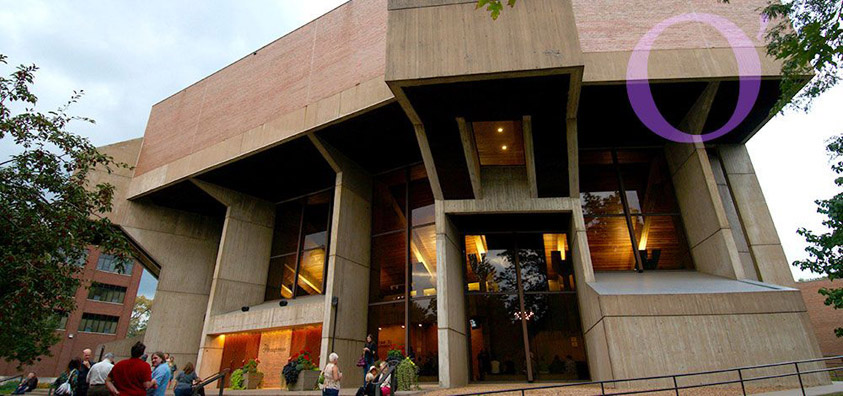
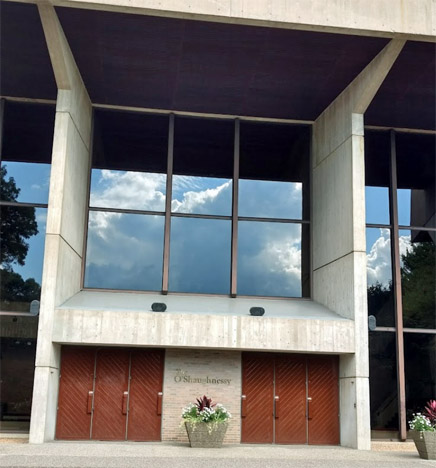
Inside there was an 1,804-seat proscenium stage theater. The stage is 52’ wide, 24’ deep, and 4 stories high. There are 20 or so adjustable acoustical panels in the ceiling.
The seats recline and the aisles are on the sides only, described as “continental style.” When it opened, in pure ‘70s style, the seats were in alternating rows of orange, red, magenta, and purple.
The space was designed to be adapted to a 600-seat space by lowering the ceiling of the venue, shutting off the balcony. In comparison, Northrop Auditorium, at the University of Minnesota, has 4,800 seats, which can be a lot of seats to fill. O’Shaughnessy is also more intimate than the 2,700-seat St. Paul Auditorium. And it was superior to the Guthrie, with 400 more seats, better acoustics, and a setting built for concerts, not for plays.
The new hall was dedicated by the Minnesota Orchestra on October 1, 1970. Appropriately, the Orchestra played Beethoven’s “Consecration of the House Overture.” The Minnesota Orchestra immediately became one of the most frequent users of the auditorium, alternating between O’Shaughnessy in St. Paul and Northrop in Minneapolis.
Other groups that appeared frequently in the early days before Orchestra Hall was built in 1974 were:
- The Mozart Festival
- The St. Paul Opera
- The St. Paul Chamber Orchestra
- The Schubert Club
- The Bach Society
In addition, the auditorium was used for recitals, dance, theater, lectures, choirs, and films.
POPULAR CONCERTS
A newspaper search turned up several non-symphonic concerts, and 99 percent of them would fall into the “mellow” category. The following is a list of the pop concerts found from 1971 through 1974 (the end of this website). Please Contact Me if you know of any more or if you have any stories!
GYPSY WITH COPPERHEAD
Gypsy with Copperhead, January 10, 1971. These were the two rock groups to play the hall, and according to reviewer Jim Gillespie, the venue was better suited to acts such as John Sebastian than to hard rock. Gillespie noted the understaffed ticket office, which caused people to stand in line and the concert to start 45 minutes late.
Gillespie found the music “rather disappointing.” Copperhead was an eight-man horn band whose musicianship was at a high level, but their original material was, “for the most part, bland and uninspired. They did a lot of jamming but only seldom did anything worthwhile come together.
Gypsy had released their first [eponymous] album a few months ago, and had been playing places like the Fillmore East in New York, where they were very well received.
The music is a successful blend of hard rock and softer, almost jazz-like strains. Their strongest point is the soaring harmony the vocalists have worked out. At times they sound almost as sweet as CSNY. They are all good musicians but the lead guitarist was the outstanding and he doubled on flute and piano also. (Minneapolis Star, January 11, 1971)
One source says that Gypsy returned on February 4, 1971, but I couldn’t find it again.
ALLMAN BROTHERS
The Allman Brothers, with the Litter, March 25, 1971 (two shows)
Both Jim Gillespie (Minneapolis Star) and Scott Bartell (Minneapolis Tribune) published gushing reviews for this show on March 26, 1971. In fact, Gillespie was afraid his review was going to sound like a paid advertisement.
The six piece band members were:
- Jai Johanny Johanson: Drums
- Butch Trucks: Drums
- Duane Allman: Guitar, slide guitar
- Dicky Betts: Guitar
- Berry Oakley: Bass
- Gregg Allman: Organ, Piano, Vocals
Gillespie couldn’t say enough about the the talent of the band:
Allman’s guitar playing is absolutely astounding. I’ve seen Clapton, Hendrix, B.B. King and just about everybody else recognized as a top guitarist, and when Allman is play well, none of them can touch him. . . On the first song [Statesboro Blues], he was hitting notes that other people do not seem to have discovered yet, and he got better as the concert progressed. The second show must have really been a knockout.
One big problem was that the public address system was severely malfunctioning, intermittently cutting off the vocalist’s microphone and making it impossible for Gregg to sing.
Also, a sad note on Gillespie’s review, when he wrote, “it boggles the mind to think of where they will be a year from now.” Duane Allman died in a motorcycle crash just seven months after this show, and bassist Berry Oakley died in November 1972. The band went on, but without their amazing talent.
Reviewer Bartell noted that the band played “Someday Baby,” an unnamed sixth piece that lasted 20 minutes, and their final number, “You Don’t Love Me, Baby,” also 20 minutes. PA problems prevented an encore, but “lack-luster” emcee Marilyn from KQRS was unable to explain because her microphone was dead as well.
Bartell did write about the opening act, the Litter, who also got the raw end of the sound system, wasting a lot of their time.
As I remember, they used to be more interesting – now they just seem affected, especially on their farther-out numbers. . . . Their last song, an original piece of pseudo-Fifties rock ‘n’ roll called “Ozone,” was pretty good, though, and they got through it all right.
QUICKSILVER MESSENGER SERVICE
Quicksilver Messenger Service, with Brewer and Shipley, April 7, 1971 (2 shows). Brewer and Shipley also played on April 29 at the Whole Coffeehouse at the U of M. No review found.
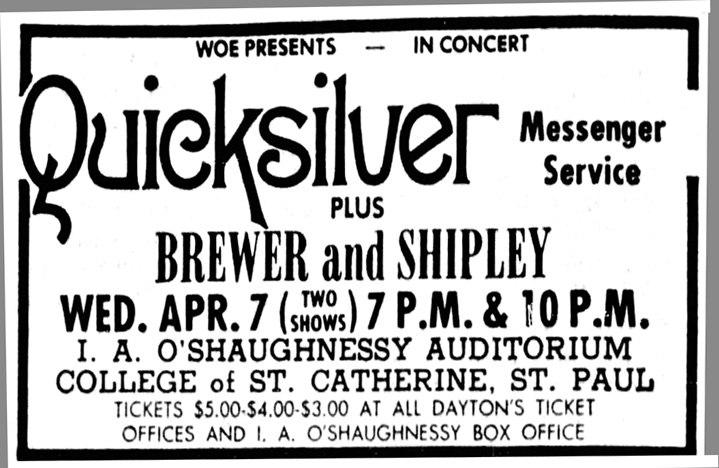
John Baldry with Madura, September 19, 1971. No review was found.
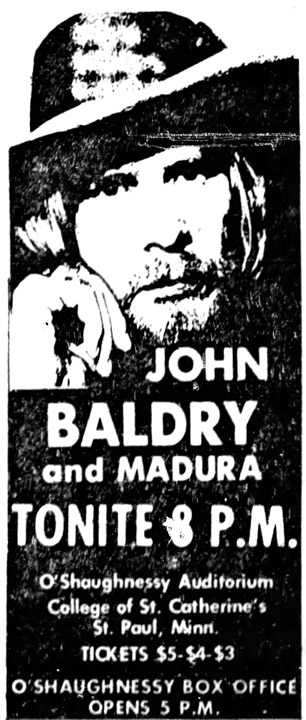
Don Ellis and Friends appeared at O’Shaughnessy Auditorium on September 25, 1971. Advertised in Minneapolis Tribune, September 19, 1971. No review found.
Crow and Willie and the Bumblebees, October 18, 1971. (Insider music calendar, October 1971)
The Insider advertised that Roberta Flack would appear at the O’Shaughnessy Auditorium on November 6, 1971 for two shows, but there is no evidence in the Minneapolis newspapers that this actually happened.
PENTANGLE
Pentangle was at the O’Shaughnessy on November 28, 1971. No review found.
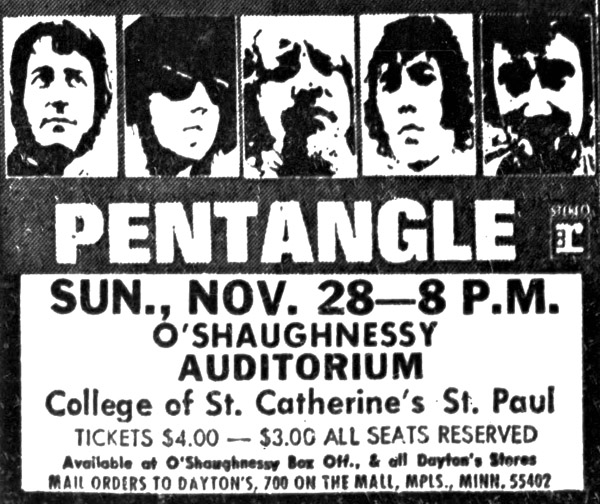
THE SWINGLE SINGERS
The Swingle Singers performed with the Minnesota Orchestra on November 11, 1971.
The Swingle Singers formed in 1962 in Paris by American Ward Swingle. The group consisted of eight session singers who put out albums of Classical and jazz, rendering them five Grammy awards. In 1973, Swingle disbanded the original French group when he and his family moved to England. (Wikipedia)
Swingle believed that the human voice was the “first and best of musical instruments.” (Minneapolis Star, November 10, 1971)
The work presented was an avant-garde composition called “Sinfonia,” by Luciano Berio, written for the Swingle Singers in 1968. The Swingles were apparently known for use of unusual vocal effects. “Sinfonia’s” five movements could be a “source of puzzlement” to one listener, and “just plain annoyance” to another, noted reviewer Mike Anthony (Minneapolis Tribune, November 12, 1971). Anthony himself found it “totally engrossing,” more so after each hearing.
The third movement featured the text from Beckett’s “The Unnamable,” read by Swingle himself. The fifth movement was added later, and Anthony found it to be the least satisfying – “much more diffuse and unstructured than the rest.”
A symphony was performed after the intermission, but the Swingle Singers were not mentioned as participants.
1972
GORDON LIGHTFOOT
On January 23, 1972, Gordon Lightfoot performed two sold-out shows. It was his third appearance in the Twin Cities, the first to being at the Guthrie in 1970 and 1971. The 1972 shows were promoted by Music Sphere Productions (Fred Krohn).
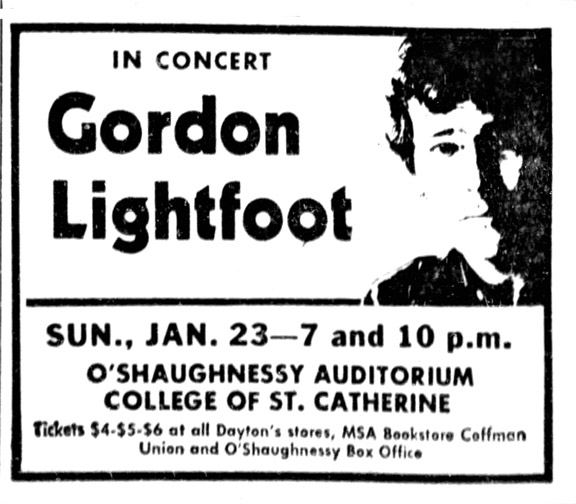
Lightfoot’s sidemen were Rick Haynes, his usual bass player, and Terry Clements, who replaced Red Shea on lead acoustic guitar.
Glenn Elvig was at the concert and wrote:
I had finished an interview with Gordon earlier in the day as part of my radio gig at WMMR [U of M campus radio.] Then…thanks to Fred Krohn, who was promoting Lightfoot at the time….and all time after that as well….I had a wonderful seat backstage. Again, forever thanks, Fred.
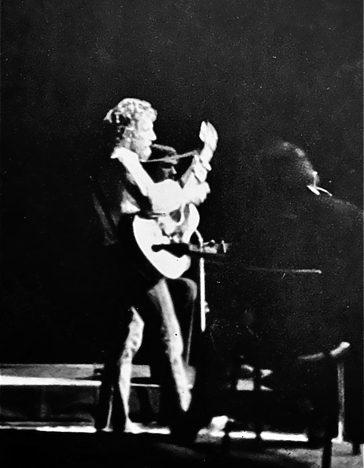
Peter Altman of the Minneapolis Star (January 24, 1972) reported that Lightfoot (sporting a new “russet beard) introduced several new songs from his upcoming album, “Don Quixote,” due out soon.
Songs performed included:
- Susan’s Floor
- Ode to Big Blue
- Through the Hills and Through the Valleys
- You’re Beautiful
- Ten Degrees and Getting Colder
- Canadian Railroad Triolgy
- Pony Man
- Miguel
Altman was “mildly dissatisfied;”
There was nothing flagrantly wrong with any of the songs, but a sense of occasion and committed involvement sometimes was lacking. There was a tendencey, encouraged by the fact that his manner is always low-pressure, to think at times, that Lightfoot was only going through the familiar motions.
M. Howard Gelfand of the Minneapolis Tribune (January 24, 1972), however, found Lightfoot’s performance “quiet, even, predictable, but thoroughly professional. No disappointments, no surprises.
While Altman’s complaint about the sidemen was that the new guitar player was not as good as the old one, Gelfand noted that they were seated in near darkness, were not introduced until the end of the concert, and although they provided vocals, they were not provided microphones.
Gelfand also noted that while Lightfoot could “toss off a few one-liners between songs, [he] seems incapable of humor or irony in his lyrics. Lightfoot also went off on a “rambling jive” on the plight of the endangered whale, which confused the audience and was met with “confused laughter.” This ended with a song about Moby Dick.
Both reviewers had nothing good to say about the husband and wife opening act, Kris and Dale O’Brien. While Altman kindly just called them “dull,” Gelfand really tore into them, calling them:
folksingers who represent all that I’ve always found repugnant in folk music – wasteful arrangements, melodramatic voices, stagey dynamics, unoriginal interpretations of “old standards,” even Edwardian costumes. They were accompanied by Mas Swanson, whose delightful, soaring flute was sated amidst such pap.
DELANEY AND BONNIE
Delaney and Bonnie and Friends, with Kevin Odegard and Friends, February 22, 1972. This was Delaney and Bonnie’s second appearance in the Twin Cities – they had been here for Open Air I in 1971.
Although this concert was billed as Delaney and Bonnie and Friends, the “and Friends” concerts featuring such luminaries as Eric Clapton were behind them. In fact, this was one of Delaney and Bonnie’s last concerts, as they divorced in 1972.
Reviewer Roy M. Close (Minneapolis Star, February 23, 1972) wrote that, from their records he expected a combination of blues, gospel and rock that characterized Delaney and Bonnie’s music. He found instead that they were more influenced by jazz than he had realized.
What really disturbed him was the volume of the concert, which, on a decibel scale, was “somewhere between the buzz of a chain saw and a jet take-off.” No lyrics could be heard, and at times it was difficult to determine what songs were being sung.
Contributing to volume was the powerful seven-piece backing band, which included:
- Trumpet
- Trombone
- Saxophone
- Electric Organ
- Drums
Delaney Bromlett sang and played guitar.
Kevin Odegard’s band was made up of Stan Kipper, Andy Howe, Greg Anderson, Dick Hiebeler, and Larry Ankrum. Close’s review said that the group’s lead singer’s name was announced as “Kevin Overgard.” He didn’t do the group any favors with his review:
Although its drummer and bass guitarist played with reasonable dexterity, for most of its short set the group looked nervous and sounded out of tune.
Early times.
PETER YARROW
Peter Yarrow, March 18, 1972. This was his first concert on his first major tour since Peter, Paul, and Mary split up. It was a benefit for Youth Citizenship and American Indian Funds for St. Catherine’s. (Minneapolis Star, March 16, 1972) No review found.
Leo Kottke, May 27, 1972. (Insider music calendar, May 1972) (no newspaper matches)
PETER YARROW
Peter Yarrow, formerly of Peter, Paul and Mary, gave a benefit performance on October 2, 1972 with local entertainer Cyril Paul. Proceeds went to the International Assembly of Christians in Solidarity with the Vietnamese, Laotian and Cambodian Peoples. Between the time PPM broke up in 1970 and October 1972, Yarrow had made more 400 free appearances for social concerns, peace rallies, and voter registration drives. (Minneapolis Tribune, October 2, 1972)
No review found.
JUDY COLLINS
Judy Collins, December 6, 1972, presented by Fred Krohn. Two shows. Reviewer Peter Altman found Judy to be less guarded and more free and relaxed than she had been in previous shows.
She played guitar and piano, and was accompanied by:
- Richard Bell, piano
- Gene Taylor, bass
- Susan Evans, drums
Songs included:
- City of New Orleans
- The Fishermen Song, which she accompanied herself on the autoharp
- The Hostage
- I Always Cook With Honey
- Secret Gardens of the Heart
- She is a Weaver
- In My Life
- Both Sides Now
- Open the Door
- Someday Soon
- My Father
- Suzanne – solo
Altman:
Maybe Ms. Collins artistic self-expression the past few years has had a liberating effect on her; perhaps something else lately has lit her up. At any event, she was splendidly vital and together yesterday – and still absolutely scrupulous about her craftsmanship. Her performance could scarcely have been more gratifying. (Minneapolis Star, December 7, 1972)
One anecdote: Dave Ray opened but was not introduced. After showered with boos, it was announced that the performer was indeed Snaker Ray, and the audience was stunned.
1973
MARY TRAVERS
Mary Travers and Jesuit Priest Daniel Berrigan, January 14, 1973 – an Evening of Poetry and Music. Benefit for the International Assembly and Berrigan’s Defense Fund. Berrigan had served time in prison for his radical non-violent protest of the Vietnam War. No review found.
GORDON LIGHTFOOT
Gordon Lightfoot performed two sold-out shows February 11, 1973.
Reviewer Marshall Fine opined that although Lightfoot had reached his creative peak about two years ago, he was only discovered by the public at that time. So as his popularity has grown, his creativity has declined.
This is not to say that Lightfoot is a less-than-adequate performer. There is still the feeling of despair and poignant despondence which his songs communicate so well. He still produces interesting images and paints vivid word and music pictures and melodies.
But music was changing and Fine wrote that Lightfoot lacked vitality – had not stayed fresh. Fine was comparing him to Elton John and Carly Simon, and calling Lightfoot slightly anachronistic, not coming out of the sixties into the seventies.
Fine did have much more praise for the opening act, the Muledeer and Moondogg Medicine Show. These were two young men from South Dakota, one of which had to have been the comedian Gary Mule Deer. They “had the audience laughing loudly at references to drugs, sex and religion.” (Minneapolis Star, February 12, 1973)
KRIS KRISTOFFERSON AND RITA COOLIDGE
Kris Kristofferson and Rita Coolidge, March 31, 1973 (two shows). Both shows had been sold out for ten days.
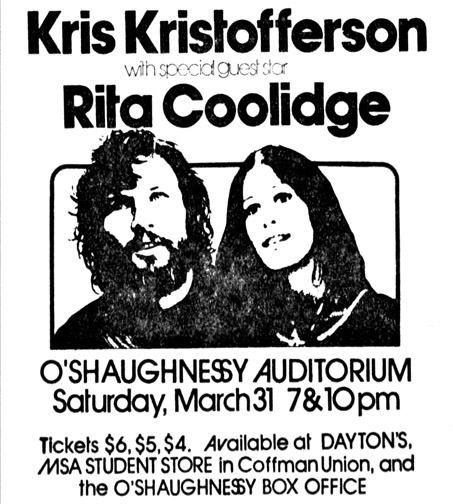
Bad weather in Chicago forced the first show to start one hour late, but he stayed for and hour and 45 minutes.
Kristofferson’s songs included:
- The Late John Garfield Blues
- Out of Mind, Out of Sight
- Jesus Was a Capricorn
- Okie From Muskogee
- Sunday Mornin’ Comin’ Down
After the first hour he brought out Coolidge and they sang:
- It Sure Was Love
- Me and Bobby McGee (finale)
- Billy the Bum (John Prine)
- My Crew
- Help Me Make it Through the Night
Coolidge sang alone:
- Fever
- A Woman Left Lonely
- I’ll be Your Baby Tonight
There were five sidemen, including:
- Stephen Burton: Guitar
- Terry Paul: Bass
Reviews:
- Roy M. Close, Minneapolis Star, April 2, 1973
- Michael Anthony, Minneapolis Tribune, April 2, 1973
ERIC WEISSBERG AND DELIVERANCE
A show called “Dueling Banjos,” starring Eric Weissman and his band Deliverance, was presented on May 4, 1973.
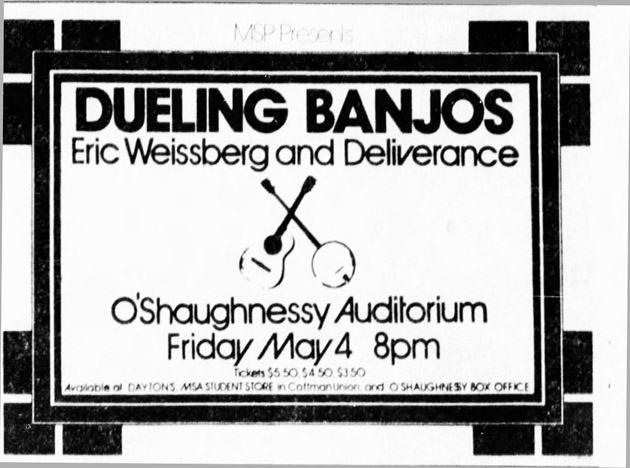
The Back Story
The song “Dueling Banjos,” from the movie “Deliverance,” had a local connection. Allen Abrams, sales director of Warner/Elektra/Atlantic Records for the Minneapolis region, heard the song in his car in October 1972, but his promotion staff didn’t have it. He called WCCO and found that it was a promotion record sent out by Warner Bros. films. Abrams called Warner Bros. to see if they were going to release it, and told them he could sell 4,000 or 5,000 copies. The guy at Warners said “That’s the worst piece of crap I ever heard,” but agreed to release it. Abrams’ promotion staff had to get WCCO to keep playing their copy of the record until stock arrived.
Abrams suggested that Warner Bros. come up with an album, and thought that John Hartford could do it, but Warners found an album on Elektra by Eric Weissberg and Steve Mandrell. They leased the album from Elektra, changed the cover, and that became the Dueling Banjos album. The single was certified as over a million seller, and the album was certified as earning over a million dollars. (“The Making of a Record,” Connie Hechter, The Insider, July 1973)
For its role in selling a million records for Warner Bros, WCCO was awarded a gold record. An article in the Minneapolis Tribune’s TV Week (June 3, 1973) reported that Denny Long, the station’s music director, had discovered the record and urged its play. Among those who played it were Roger Erickson, Chuck Lilligren, and Howard Viken. The gold record was presented by Warner Bros. representatives Abrams and Cliff Siegel.
The Concert
Concert reviewer Marshall Fine noted that the group had only been together a month and a half, and had yet to determine a focus for the band – was it bluegrass or country & western? Each 30 minute concert was half and half.
Musicians included:
- Weissberg on banjo and pedal steel
- Charlie Brown, lead guitar
- Steve Mandell, rhythm guitar
- Tony Brown, bass and vocals
Fine found the country songs lacking in life and slow in pace, but he gave high marks to Weissberg’s banjo playing and Brown’s guitar.
[Addendum:
31 years later, Weissman would recreate the moment, this time with Peter Oshtrushko at the Pantages Theater on February 3, 2004.
The song was actually written by Arthur “Guitar Boogie” Smith in 1955, and he sued when he was not credited as the author.]
Opening the show was local singer Ted McGill, “who offered a half-hour of pleasant, if somewhat ordinary, singing and some good acoustic and electric slide guitar playing.” (Minneapolis Star, May 5, 1973)
JOHNNY SMITH
Guitar player Johnny Smith performed on October 5, 1973. Smith was a cool jazz and contemporary guitar player who wrote “Walk, Don’t Run” in 1954. The show was a benefit for the Scoliosis Research Fund. (Minneapolis Tribune, October 5, 1973)
TONY BENNETT
Tony Bennett graced the O’Shaughnessy stage on October 12 and 13, 1973, singing the songs of Rodgers and Hart. Both shows were sold out.
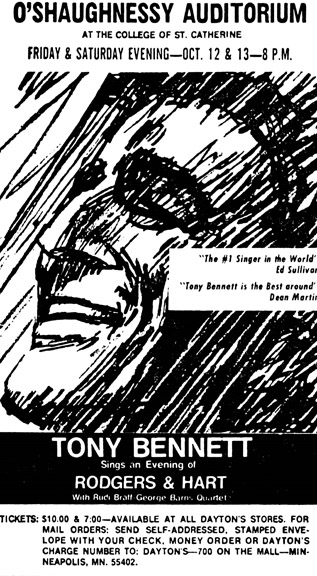
Bennett was backed by the Ruby Raff (trumpet) – George Barnes (guitar) Quartet.
Songs included:
- Blue Moon
- The Lady is a Tramp
- Mountain Greenery
- Thou Swell
- I Left My Heart in San Francisco – encore
Reviewer Marshall Fine noted that Bennett was rather non communicative, saying little between songs. He also noted that the 60-minute show was rather short. (Minneapolis Star, October 13, 1973.)
JUDY COLLINS
Judy Collins, October 19, 1973 (two sold out shows)
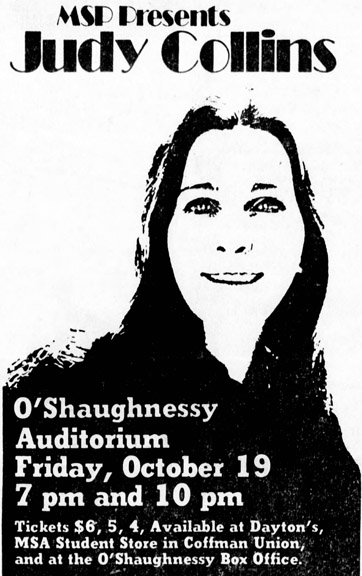
Reviewer R. M. Close (Minneapolis Star, October 20, 1973) wrote that the first show was 90 minutes long, and Ms. Collins concentrated on her latest album, “True Stories and Other Dreams.” Songs included:
- The Hostage
- The Fishermen Song
- Song for Martin – accompanied by autoharp
- Holly Ann
- Suzanne
- Both Sides Now
- City of New Orleans
- Chelsea Morning
- Who Knows Where the Time Goes
Judy played the piano and 6- and 12-string guitar, in addition to the autoharp. Her band consisted of:
- Richard Bell, piano
- Mark Horowitz, pedal steel guitar
- Gene Taylor, bass
- Don Brooks, harmonica
- Bo Siegel, drums
- Steve Mandel, guitar
KRIS KRISTOFFERSON
Kris Kristofferson performed two sold out shows on November 30, 1973.
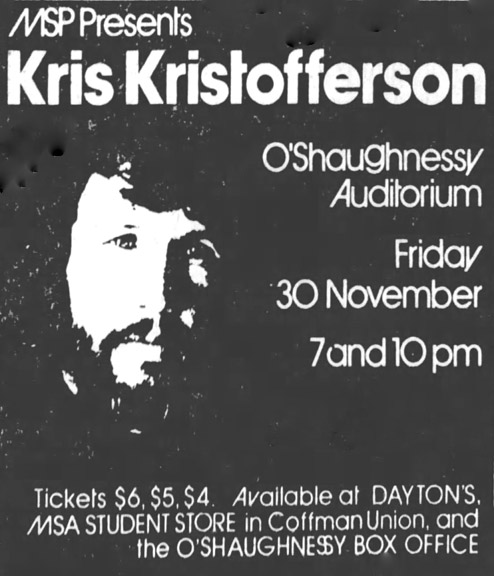
Usually appearing with his wife Rita Coolidge, this time Kris was on his own, and the show was a “flop,” according to reviewer Roy M. Close. Most of the problem was that his voice grew increasingly hoarse, so by the end of the first show, “Help Me Make it Through the Night” took on a new meaning. There were also problems with the sound equipment, and Close felt that members of his band, two of which were new, did not play cohesively. Kris’s apology for how badly he felt about it all was an “unpardonable mistake,” opined Close, and “never improves matters.”
Songs included “Out of Mind, Out of Sight” and “Searching.”
At the point in the show where he normally would have brought Rita onstage, he introduce a young singer named Bob Neuwirth, who sang humorous songs, including a parody of “Vincent,” and an “overly loud rocker.” Then KK’s pianist, Donnie Fritts, sang a couple of his own songs. (Minneapolis Star, December 1, 1973)
1974
Ian And Sylvia were booked by Fred Krohn for January 18, 1974, but cancelled for personal reasons.
NEW BIRTH AND THE MYSTICS
New Birth, opened by the Mystics, performed on February 11, 1974. New Birth was an R&B band and the Mystics were a longstanding popular local band.
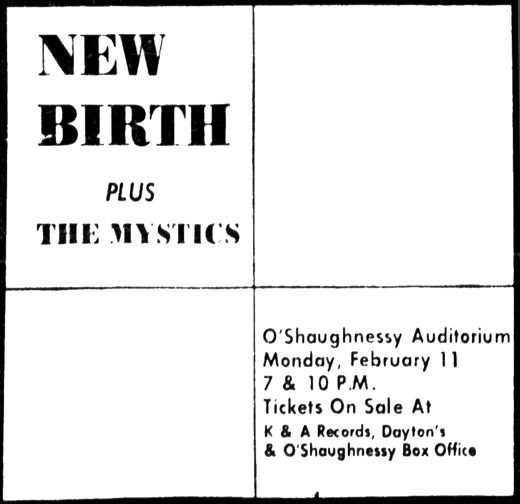
GORDON LIGHTFOOT
Gordon Lightfoot’s two shows on February 17, 1974, filled up so fast that a third show was added the next night, February 18, (Presidents’ Day) at 7:30 pm.

Charles Quimby reviewed the concert for the Minneapolis Star (February 8, 1974), providing us with some details. He wrote that Lightfoot drew about equally from his past repertory and his latest album, “Sundown.” Although he made efforts to establish rapport with his audience, it was his songs that enthralled the crowd.
Songs performed included:
- If You Could Read My Mind
- Ten Degrees and Getting Colder
- You’re Beautiful (which to Quimby sounded similar to If You Could Read My Mind)
- The Auctioneer
- Divorce Country Style
Lightfoot’s sidemen were Terry Clements on lead acoustic guitar and Richard Haynes on bass, providing “capable and unobstrusive instrumental and vocal support.”
The opening act was a 40-minute set with the Talbot Brothers, former members of Mason Profitt.
Quimby:
Their performance featured harmonies and guitar work which were pleasant enough, but in contrast to Lightfoot’s, their lyrics were pallid and sometimes ludicrous.
Michael Anthony of the Minneapolis Tribune (February 19, 1974) reviewed the Sunday night Lightfoot show, and found the music “totally engaging and professionally done.” He noted that the stage was decorated with potted ferns, and that Lightfoot “seemed as potted as the ferns” – both reviewers noted that he looked like he had been drinking, and he admitted it on stage.
His set was 70 minutes long, and in addition to the songs listed above, he sang:
- Cotton Jenny
- Alberta Bound
- Canadian Railroad Trilogy (closer)
- Sundown
Anthony reveals the names of the Talbot Brothers to be John and Terry.
It might be argued that the type of music they do – “Goin down-to-Jordon-the-Indian-gotta-hammer-in-his-hand” – is too much of the full-voiced, socially conscious but dated folk music of the late 1950s and early 1960s. But the Talbots have very good voices. And you never know what kind of music is just around the corner.
HERBIE MANN
Flutist Herbie Mann, with David “Fathead” Newman performed two identical benefit shows on March 1, 1974. The concerts were benefits for the St. Paul Chamber Orchestra.

Herbie Mann was perhaps the most widely recognized flutist in the country, wrote reviewer Charles Quimby (Minneapolis Star, March 2, 1974), making nearly 50 albums by 1974 and almost single-handedly legitimized the flute as a jazz instrument. The appeared with a seven-man ensemble, including Tony Levin on bass and Sam Brown on guitar. David Newman played tenor sax. In addition to the drummer, there was a second percussionist who was in charge of bells, chimes, and a gong.
Songs included the familiar “Push-Push,” but also the Rolling Stones’ “Bitch. Musicians took solos on numbers called “The Nighttime is the Right Time” and “Sunrise High.”
ANNE MURRAY
Anne Murray, March 8, 1974, 8pm
Murray had been in the Twin Cities before, supporting Bobby Goldsboro in a Grandstand show at the 1972 State Fair, but this 1974 show was her first major concert on her own, and she drew a capacity crowd. Although she drew a standing ovation, and reviewer Peter Altman found her to to be exceptionally youthful and fresh, he also found a number of “consequential flaws.”
She was backed by a seven-man band called Richard, which included:
- Trombone
- Saxophone
- Flute
- Guitars
- Piano
- Electric bass
- Drums
Plus six string players.
The show started with a half-hour set by Richard, played without much dynamism, according to Altman. All these players slowed the momentum and got in the way of Murray’s singing. In all, the accompaniment was “excessive and not very interesting.”
In addition, Altman had a problem with Murray’s material. He said she has not figured out what to sing, and didn’t know how to package herself. Her material ranged from gospel blues to country to super-commercial pop. He called her material “bland” and “slick,” and her arrangements “fussily over-complex.” Many songs had a somewhat synthetic smoothness. (Minneapolis Star, March 9, 1974)
SANDLER AND YOUNG
Sandler and Young, April 5 and 6, 1974. No review found.
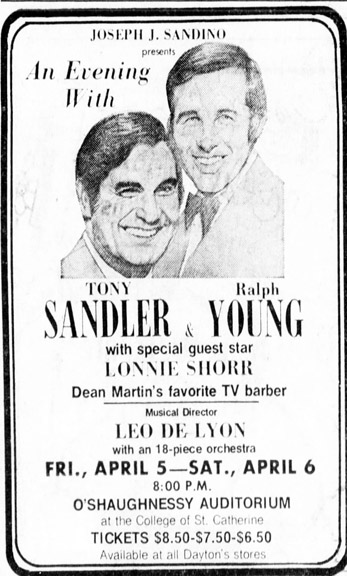
UP WITH PEOPLE
Up With People gave two shows on April 20 and 21, 1974 (one show each day).
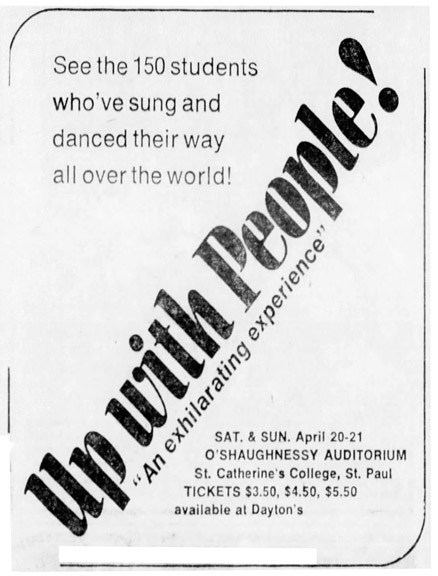
Up With People was started by J. Blanton Belk in 1965 as a kind of clean-cut alternative to hippie protestors. Large casts put on shows all over the world at events like the Super Bowl and in front of world leaders. Members stayed with guest families as they traveled. Members were aged 17 to 25. The message of Up With People was that the world’s greatest natural resource is its young people.
This appearance was sponsored by Village Chevrolet. The group also performed a free mini concert on April 19 at 12:30. The cast of 110 singers, dancers, and musicians was one of three troupes traveling the country. The music combined folk, rock, country, and jazz. They traveled with seven tons of stage, lighting and sound equipment. Professors traveled with them as they continued their education, and they received accreditation through the University of Arizona. They were on the road 10 months out of the year. (article uncited)
Rod McKuen, , May 10, 1974, 7 & 10
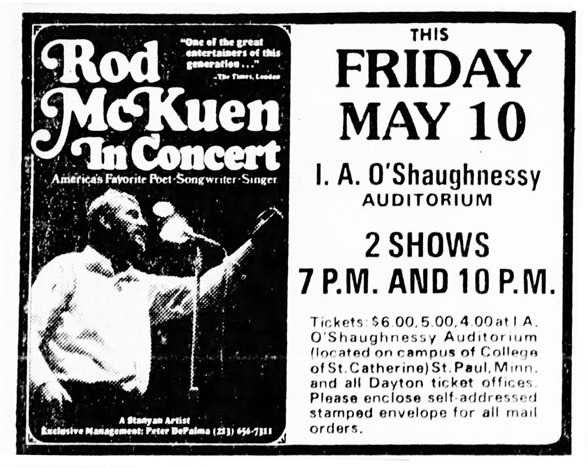
DAVE BRUBECK AND SONS
Dave Brubeck and Sons Darius, Chris, and Dan with St. Paul Chamber Orchestra, May 14 and 15, 1974, 8 pm. Two different programs. $15/seat plus party with band after Wednesday’s show. Members’ Lounge of the St. Paul Arts and Science Center, 30 E. 10th Street, Downtown St. Paul. Benefit for the orchestra’s Musicians’ Annuity Fund.
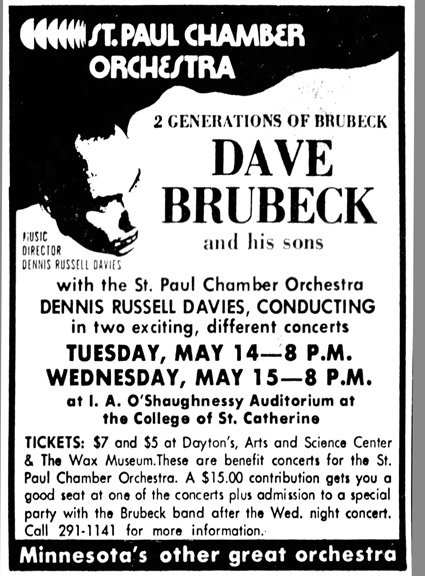
EDDIE KENDRICKS
Eddie Kendricks, opened by Graham Central Station, May 16, 1974, two shows.
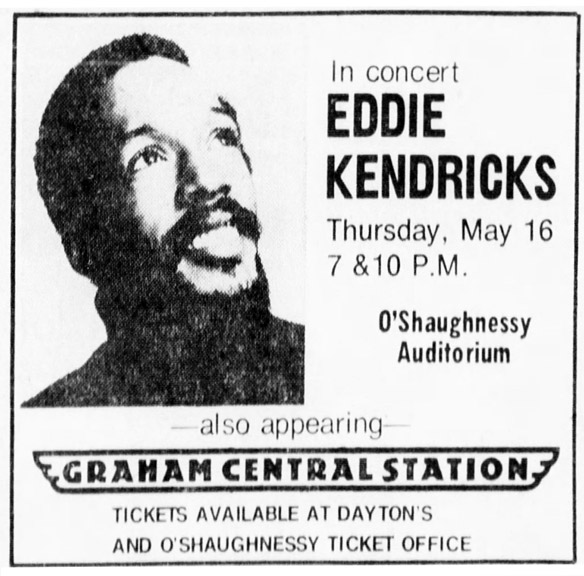
Jon Bream, in his “R ‘n’ R Hootchie Koo” column in the TC Express magazine (July 1, 1974), reported that that there was a big problem, because Graham Central Station had just opened for Herbie Hancock at the Guthrie ten days earlier.
Most acts won’t come back to the same market for at least 30 days, and there are usually riders in their contracts with this stipulation. When this was pointed out to the agent, she asked, “Is St. Paul in Minnesota? Oh, I guess it is. Well, where is it?” “Across the river from Minneapolis.” “Oh.”
Again, Jon Bream:
First appearance by a major mainstream R&B act in the Twin Cities in more than a year. First time promoter Philip Fields should be commended for his efforts. The only glaring flaw was the woefully inadequate sound system; Graham Central Station sounded more together 10 days earlier doing the same material at the Guthrie. The young crowd, determined to party, seemed a bit insensitive (O aint no discoteque) to the nuances of Kendricks’ material, the highlight of which was an old Tempations’ medley. (Twin City Express, June 3, 1974)
BOBBY LYLE
Bobby Lyle and jazz group Skyle with St. Paul Chamber Orchestra, May 24, 1974, 8 pm. Bobby Lyle was an organist whose family moved to Minneapolis when he was one year old. He attended Macalester College in St. Paul. On June 17, 1973 he was named the Champion at the Yamaha Electone Organ Festival before over 2,000 in Chicago. He won $1,000 and an expense-paid trip to Japan in October 1973 to compete in the International Yamaha Electone Festival. In 1974, Lyle and his family moved to Los Angeles.
MARLENE DIETRICH
Marlene Dietrich was booked for two shows on May 26, 1974, 7 & 10, at a high (for the time) ticket price. Promoter Fred Krohn was reportedly paying her over $10,000 for the appearance.
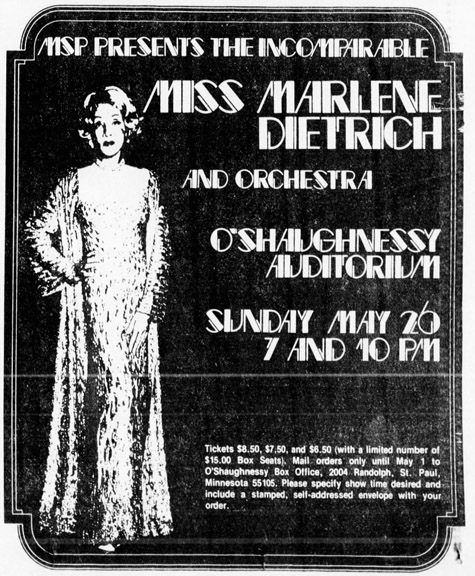
The second show cancelled because only 200 tickets were sold, so chairs were brought in to accommodate those with tickets to the late show.
This was to be Ms. Dietrich’s first visit to the Twin Cities, said her agent. It was reported that she would wear a Paris-designed rhinestone and sequin dress, valued at $30,000 at her appearance. In addition, she would wear an ostrich cape with a train and artificial diamond jewelry. (Minneapolis Tribune, May 22, 1974)
Anthony described her dress as as “those same Jean Louis gowns (silver beaded) and the ubiquitous swansdown coat (she owns two, a $16,000 male and a $12,000 female).” He noted a slight limp from a previous fall. Close called it a “translucent sequined gown.”
Michael Anthony of the Minneapolis Tribune and Roy M. Close of the Star reviewed the show on May 28, 1974.
Both agreed that Dietrich really couldn’t sing:
Close:
Her tone is husky and thick, her sense of timing is weak, her range is quite limited, and she not infrequently sings out of tune.
But her lack of talent wasn’t the point.
Close again:
And what a triumph it was: a remarkable reaffirmation of the magnetism of Miss Dietrich’s public personality – an unforgettable amalgam of sophisticated sex appeal, grand style and superb control.
Anthony:
It’s rather the most impeccably polished show of its kind I’ve ever seen. and it’s a tribute to her professionalism or her love of performing or whatever that each carefully scripted word she says, each meticulously planned gesture – a wrist movement timed to a piano plunck from conductor Stan Freeman – hasn’t gone stale in a show she’s been doing with little alteration for over 20 years. (Light, sound and [21-piece] orchestra were rehearsed for two days here before the concert.)
Songs sung included:
- I’m Naughty Little Lola
- The Boys in the Backroom
- The Laziest Gal in Town
- Go Away From My Window
- Marie, Marie
- Lili Marlene
- Where Have All the Flowers Gone
- Falling in Love Again (first encore)
- Honeysuckle Rose (second encore)
- I Get a Kick Out of You (last encore)
Both reviewers determined the performance to be a triumph, and, in Anthony’s words, an “incomparable evening.”
Anne Murray, August 17, 1974, 7:30 and 10. No review found.
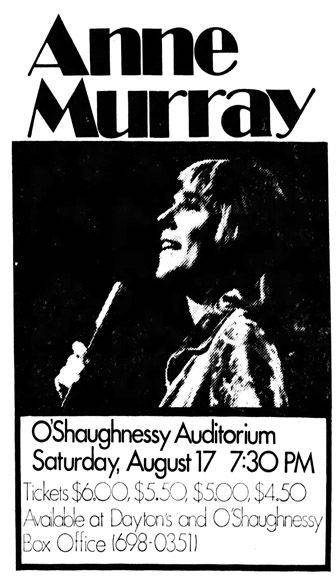
ELLA FITZGERALD
Ella Fitzgerald, September 13, 1974, 8pm. One sold-out show.
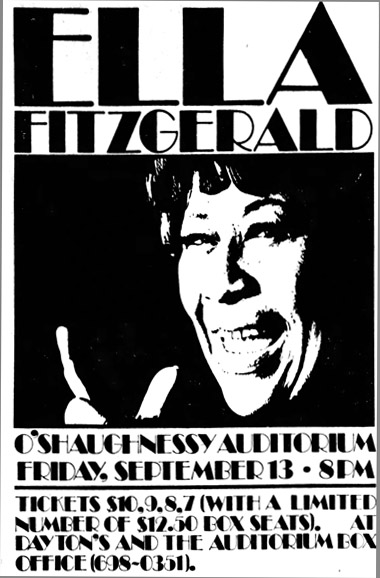
This concert was reviewed by Roy M. Close (Minneapolis Star, September 14, 1974) and Jim Fuller (Minneapolis Tribune, September 16, 1974). Both thought the concert was superlative, and had nothing but good things to say about the voice and presentation of Miss Fitzgerald.
Fuller noted the she had:
lost only a touch of her original richness of voice and none of her remarkable range. Her control as she slides, leaps, and warbles up and down the scale still is astonishing when Miss Fitzgerald sings it.
She was backed by the Tommy Flanagan Trio, which also provided the opening session. The Trio included veteran trumpeter Roy Eldridge, who, in Fuller’s opinion, was a little on the old side to be as good as he once was.
The Trio provided at a set that was over 20 minutes after 8:00, and it was after 9:00 before Miss F’s set began, but she gave the audience 75 minutes of music, after two solid hours, everyone went home happy.
Songs included:
- Sweet Georgia Brown
- Good Morning, Heartache
- The Way We Were
- Miss Otis Regrets
- The Boy From Ipanema
- Donkey Serenade
- Temptation
- Fly Me to the Moon
KRIS KRISTOFFERSON AND RITA COOLIDGE
Kris Kristofferson and Rita Coolidge, September 29, 1974, 7 & 10. Music Sphere Productions. No review found.
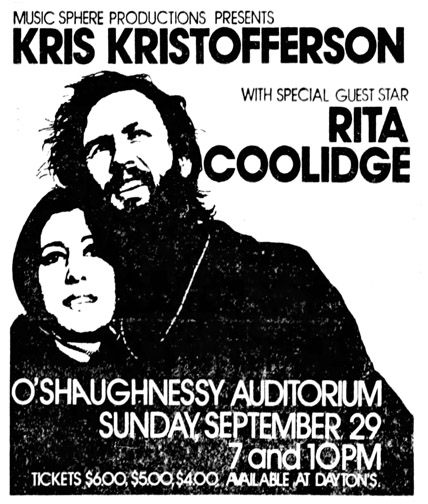
KEITH JARRETT
Keith Jarrett, jazz pianist, performed at the O’Shaughnessy with the St. Paul Chamber Orchestra on December 21, 1974. 8 pm.
Jarrett was in town to perform four concerts in the Twin Cities: (Minneapolis Star, December 16, 1974)
On December 17, 1974, he performed his own works at the Janet Wallace Fine Arts Center at Macalester College with the St. Paul Chamber Orchestra.
On December 18, 1974, he performed at the Walker Art Center. This concert was also with the St. Paul Chamber Orchestra and included works by Hayden and John Cage.
On December 21, 1974, Jarrett’s third concert with the St. Paul Chamber Orchestra took place at the O’Shaughnessy.
The show opened with Felice Magendanz’s performance of Haydn’s Cello Concerto in C Major. Next, soprano Barbara Nelson and alto Michaela Mahady sang the Bach cantata “Gelobet seist Du, Jesus Christ.” Reviewer Roy M. Close wrote that these performances rendered the program a “remarkably miscellaneous affair” with “something for everybody.”
Jarrett played two works. First was his his own composition, “In the Cave of the Light,” scored for piano, strings, gong, and percussion, running 14 minutes. Close reported that it “struck me as a pleasant but not memorable display of instrumental pastels – sort of jazzified Ravel.”
The second piece he played was Carla Bley’s “3/4,” which Close found rather more interesting – “a 20- minute piece of considerable variety and force.”
In general, Close found the 29-year-old Jarrett to be “prodigiously talented.” “In both pieces he strove for romanticism and richness of expression. He “handled his part masterfully,” as did the orchestra, under the baton of Dennis Russell Davies.
The fourth and last concert in the series took place on December 22, 1974, when Jarrett’s jazz group performed at the Guthrie. See the page on the Guthrie for a review of this show.


